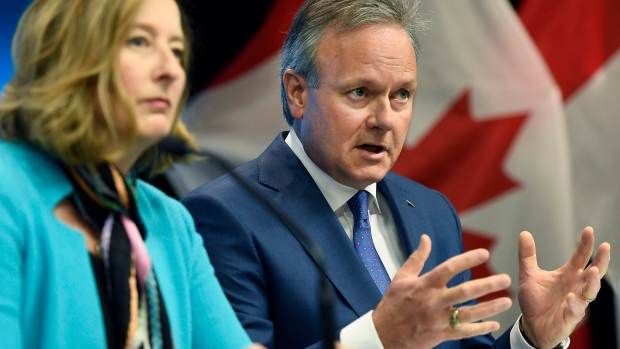Jul 11, 2018
Bank of Canada raises rates to 1.5%, highest since 2009
, Bloomberg News

Bank of Canada Governor Stephen Poloz brushed aside concerns about trade wars and pressed ahead with a fresh interest rate increase as inflation hovers at its highest in seven years.
The Ottawa-based central bank raised its overnight benchmark rate by a quarter point to 1.5 per cent on Wednesday, its highest level since 2009, in the second hike this year and fourth over the past 12 months. The statement didn’t introduce any new “dovish” language, with officials only reiterating that rates will need to rise further, albeit gradually, to keep price pressures in check.
“Governing Council expects that higher interest rates will be warranted to keep inflation near target and will continue to take a gradual approach, guided by incoming data,” the bank said.
The rate move signals policy makers are determined to bring rates back to normal levels, and are confident in the Canadian economy’s ability to cope with both higher borrowing costs and the mounting trade tensions.
In its statement and accompanying monetary policy report, the central bank described an economy running close to capacity despite growing trade frictions. Exporters, meanwhile, are doing even better than previously estimated because of buoyant foreign demand.
The Bank of Canada forecast growth will average 2 per cent over the next three years, unchanged from its last estimate in April and still slightly higher than what officials believe is the economy’s long-term sustainable pace. The latest growth forecasts incorporate negative adjustments that capture greater trade uncertainty.
The central bank also raised its estimates for inflation, but expressed confidence it would settle back to 2 per cent after temporary factors drove the rate above target.
In another positive development, officials highlighted that the composition of growth is shifting away from consumption to exports and business investment -- implying they believe the expansion is more sustainable.
HAVE YOUR SAY
What’s the biggest threat to Canada’s economy?
FULLY PRICED
Wednesday’s move was fully priced in by markets. Investors have also been anticipating additional hikes every six months or so until the benchmark rate settles around 2 or 2.25 per cent by the end of 2019 -- in line with the central bank’s gradualist guidance.
The increase in borrowing costs also puts the Bank Canada more in sync with the Federal Reserve and investors are now expecting the northern nation to keep track with rate hikes south of the border over the next year. The Bank of Canada has been lagging the Fed’s rate increases since oil prices collapsed in 2015 -- marking a rare divergence given how closely Canada’s economy is linked to the U.S.
Rate normalization is a delicate task for Poloz. With inflation already above the central bank’s 2 percent target and heading higher, and with financial conditions still very loose, the central bank chief needs to keep wage and price pressures in check. At the same time, moving too soon and too fast could inadvertently trigger a downturn at a time when the economy is awash in risk.
RATE SENSITIVITY
The Bank of Canada repeated most of the list of concerns and unknowns it has said is keeping it from an even faster normalization -- in addition to trade. Officials reiterated, for example, how the economy has become more sensitive to higher interest rates given high debt levels.
The central bank continued to show faith in the economy’s ability to prolong its current expansion without fueling inflation -- in part because it believes there remains excess capacity in the labour market. The Bank of Canada estimated underlying wage pressures are at 2.3 per cent, less than what would be expected in a jobs market that had no slack.
Policy makers are also anticipating that higher business investment will generate new capacity as companies invest to meet sales, a process the central bank has said it has an “obligation” to nurture with stimulative borrowing costs. Because business investment in the first quarter was more robust than expected, the central bank slightly increased its estimate for potential output growth in 2019 and 2020.
- Bank of Canada's Poloz predicts export pick-up despite Trump trade war
- Auto tariffs could handcuff the Bank of Canada, Poloz warns
- 'There are worries ahead': Experts react to Bank of Canada’s rate hike
RELATED: BANK OF CANADA DECISION
Other Highlights
-The central bank kept its 2 per cent growth estimate unchanged for 2018, and raised it one-tenth of a percentage point in 2019 and 2020 on stronger consumption
-The bank kept estimates for global growth unchanged from April, but said U.S. economy is stronger than expected
-Canadian dollar is lower despite higher oil prices due to broad-based U.S. dollar strength and trade actions
-Recent data suggest housing markets are beginning to stabilize
-Exports are being buoyed by strong global demand and higher commodity prices
--With assistance from Erik Hertzberg.

